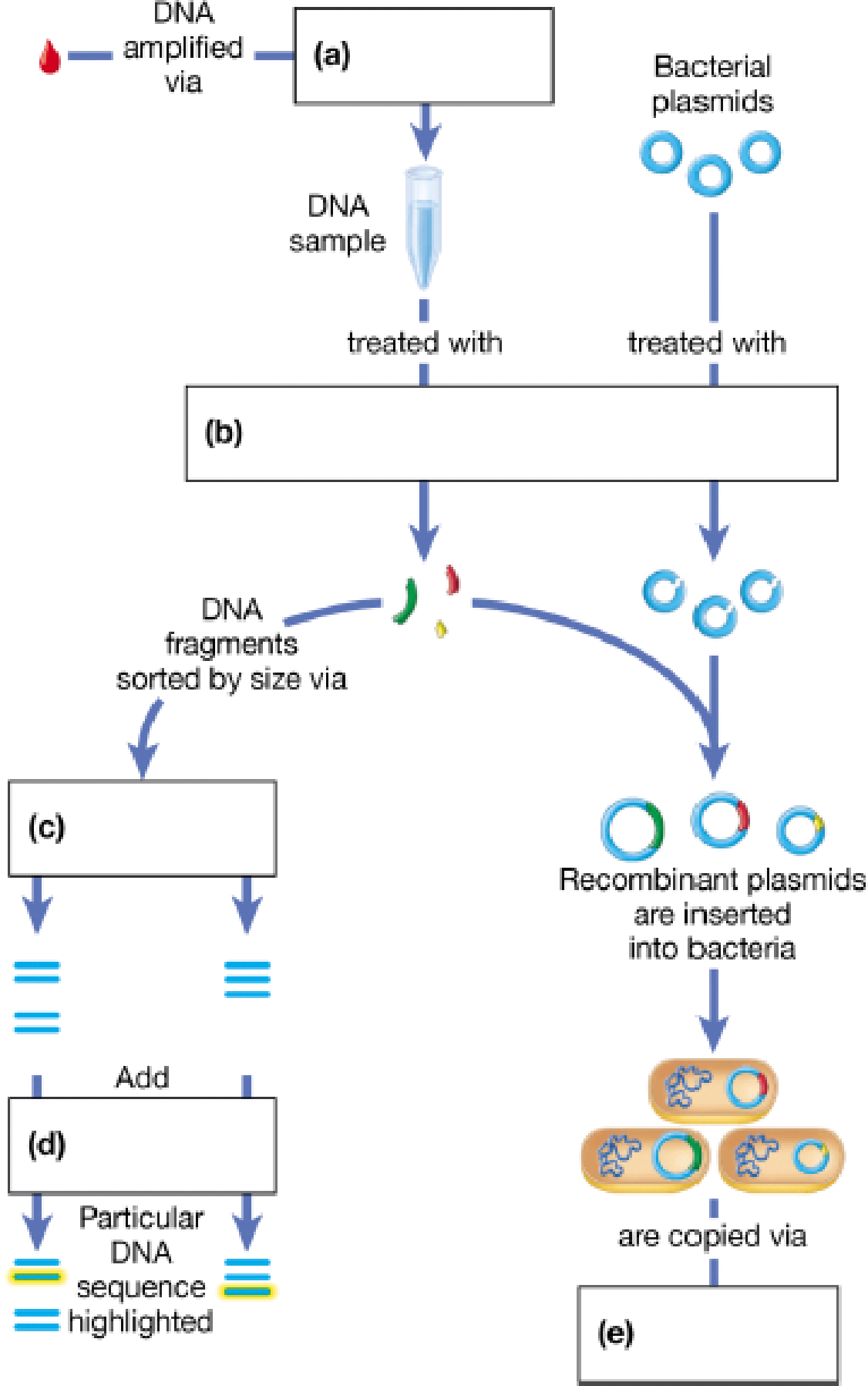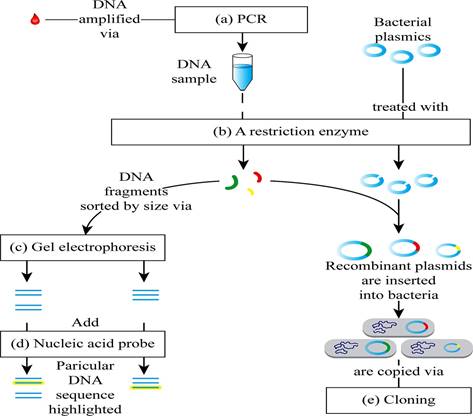
Concept explainers
Imagine you have found a small quantity of DNA. Fill in the following diagram, which outlines a series of DNA technology experiments you could perform to study this DNA.

To complete: The given map showing the steps involved in recombinant DNA (rDNA) technology.
Introduction: Recombinant DNA technology is a technique used to produce novel genetic combinations by combining the genes from two different organisms and introduces them inside a host in order to proliferate and grow.
Answer to Problem 1CC
Pictorial representation: Fig. 1 shows the completed map of the steps involved in recombinant DNA technology.

Fig. 1 The steps involved in recombinant DNA (rDNA) technology.
Explanation of Solution
(a)
Correct answer: PCR
Explanation: The polymerase chain reaction (PCR) is used to get multiple copies of DNA within a short period. In PCR, for synthesizing multiple copies of a specific DNA fragment, DNA nucleotide primers are used. Hence, the correct answer is PCR.
(b)
Correct answer: A restriction enzyme
Explanation: Restriction enzymes are a group of enzymes used to cut the DNA by binding to certain specific DNA sequence sites called as restriction sites. It forms single-stranded ends called as sticky ends. The sticky ends help the DNA to bind with the other DNA fragment that has the same single-stranded ends by complementary base pairing. Hence, the correct answer is a restriction enzyme.
(c)
Correct answer: Gel electrophoresis
Explanation: Electrophoresis is used to separate the molecules based on their size and charge in the presence of an electric field. Hence, the correct answer is Gel electrophoresis.
(d)
Correct answer: Nucleic acid probe
Explanation: Nucleic acid probe is used for the analysis of the probe, which can specifically bind to the complementary DNA strand. Hence, the correct answer is nucleic acid probe.
(e)
Correct answer: Cloning
Explanation: The process of production of identical copies of the parent cell is called as cloning. Cloning vectors are used in the rDNA technology for the propagation of the desired gene. Hence, the correct answer is cloning.
Want to see more full solutions like this?
Chapter 12 Solutions
CAMPBEL BIOLOGY:CONCEPTS & CONNECTIONS
- What did the Cre-lox system used in the Kikuchi et al. 2010 heart regeneration experiment allow researchers to investigate? What was the purpose of the cmlc2 promoter? What is CreER and why was it used in this experiment? If constitutively active Cre was driven by the cmlc2 promoter, rather than an inducible CreER system, what color would you expect new cardiomyocytes in the regenerated area to be no matter what? Why?arrow_forwardWhat kind of organ size regulation is occurring when you graft multiple organs into a mouse and the graft weight stays the same?arrow_forwardWhat is the concept "calories consumed must equal calories burned" in regrads to nutrition?arrow_forward
- You intend to insert patched dominant negative DNA into the left half of the neural tube of a chick. 1) Which side of the neural tube would you put the positive electrode to ensure that the DNA ends up on the left side? 2) What would be the internal (within the embryo) control for this experiment? 3) How can you be sure that the electroporation method itself is not impacting the embryo? 4) What would you do to ensure that the electroporation is working? How can you tell?arrow_forwardDescribe a method to document the diffusion path and gradient of Sonic Hedgehog through the chicken embryo. If modifying the protein, what is one thing you have to consider in regards to maintaining the protein’s function?arrow_forwardThe following table is from Kumar et. al. Highly Selective Dopamine D3 Receptor (DR) Antagonists and Partial Agonists Based on Eticlopride and the D3R Crystal Structure: New Leads for Opioid Dependence Treatment. J. Med Chem 2016.arrow_forward
- The following figure is from Caterina et al. The capsaicin receptor: a heat activated ion channel in the pain pathway. Nature, 1997. Black boxes indicate capsaicin, white circles indicate resinferatoxin. You are a chef in a fancy new science-themed restaurant. You have a recipe that calls for 1 teaspoon of resinferatoxin, but you feel uncomfortable serving foods with "toxins" in them. How much capsaicin could you substitute instead?arrow_forwardWhat protein is necessary for packaging acetylcholine into synaptic vesicles?arrow_forward1. Match each vocabulary term to its best descriptor A. affinity B. efficacy C. inert D. mimic E. how drugs move through body F. how drugs bind Kd Bmax Agonist Antagonist Pharmacokinetics Pharmacodynamicsarrow_forward
 Human Heredity: Principles and Issues (MindTap Co...BiologyISBN:9781305251052Author:Michael CummingsPublisher:Cengage Learning
Human Heredity: Principles and Issues (MindTap Co...BiologyISBN:9781305251052Author:Michael CummingsPublisher:Cengage Learning Biology Today and Tomorrow without Physiology (Mi...BiologyISBN:9781305117396Author:Cecie Starr, Christine Evers, Lisa StarrPublisher:Cengage Learning
Biology Today and Tomorrow without Physiology (Mi...BiologyISBN:9781305117396Author:Cecie Starr, Christine Evers, Lisa StarrPublisher:Cengage Learning Concepts of BiologyBiologyISBN:9781938168116Author:Samantha Fowler, Rebecca Roush, James WisePublisher:OpenStax College
Concepts of BiologyBiologyISBN:9781938168116Author:Samantha Fowler, Rebecca Roush, James WisePublisher:OpenStax College Biology: The Dynamic Science (MindTap Course List)BiologyISBN:9781305389892Author:Peter J. Russell, Paul E. Hertz, Beverly McMillanPublisher:Cengage Learning
Biology: The Dynamic Science (MindTap Course List)BiologyISBN:9781305389892Author:Peter J. Russell, Paul E. Hertz, Beverly McMillanPublisher:Cengage Learning Biology 2eBiologyISBN:9781947172517Author:Matthew Douglas, Jung Choi, Mary Ann ClarkPublisher:OpenStax
Biology 2eBiologyISBN:9781947172517Author:Matthew Douglas, Jung Choi, Mary Ann ClarkPublisher:OpenStax





